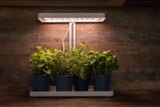How to Adjust LED Grow Light Settings for Optimal Growth
LED grow lights have become a favorite tool for many cannabis growers, thanks to their efficiency and flexibility. Unlike traditional lighting systems, LED grow lights use less energy and produce light in spectrums that can boost plant growth. As every grower knows, finding the right balance of light is a crucial part of nurturing healthy plants. Whether you're a seasoned cannabis cultivator or just getting started, understanding how to adjust your LED grow lights can make a notable difference in your plants' development.
Properly setting these lights ensures that your plants get the correct amount of light they need during each growth phase. This kind of precision leads to healthier plants and better yields, saving you both time and effort in the long run. By fine-tuning your light settings, you’re essentially giving your cannabis the best start possible. Let's delve into how these lights function and how you can make the most out of them in your growing environment.
Understanding LED Grow Lights
LED grow lights are a popular choice for indoor gardeners, and for good reason. Unlike traditional grow lights, LEDs can be tailored to emit specific spectra of light. This means you can provide your plants with the exact type of light they need at various growth stages. For instance, blue light is useful in the vegetative stage, promoting dense and compact growth. Meanwhile, red light shines during the flowering stage, encouraging buds to develop fully.
Here are some advantages of using LEDs in your hydroponic setup:
- Energy Efficiency: LED grow lights use significantly less electricity compared to other lighting options, which can help reduce utility costs.
- Cool Operation: They emit minimal heat, making it easier to maintain optimal temperatures in your grow room.
- Long Lifespan: These lights last much longer than traditional bulbs, which means less frequent replacements and lower maintenance costs.
LEDs work by using a semiconductor to convert electrical energy into light. This process is highly efficient because very little energy is wasted as heat. When setting up your LED grow lights, it's important to understand these features so you can adjust them to meet your plants' needs effectively. With the right setup, LED lights can mimic the natural sunlight cycle, which is key to vigorous plant growth.
Setting Up Your LED Grow Lights
Once you have chosen your LED grow lights, it's time to set them up to ensure your plants receive the best care. The initial setup is crucial as it lays the foundation for your plants to thrive. Start by deciding on the placement and height of your lights. Ideally, LED lights should be positioned directly above the plants, ensuring even coverage and minimizing the risk of uneven plant development. The exact height will depend on the specific model and the coverage area, but a general rule is to start at around 18-24 inches from the plant canopy and adjust as needed.
To make the most of your grow lights, follow these tips:
- Configure the Timer: Set your LED lights to mimic the natural daylight cycle. For seedlings, you might use an 18/6 light cycle (18 hours of light, 6 hours of darkness) to encourage robust growth.
- Adjust for Growth Stages: Shift the light cycle to 12/12 during the flowering stage to stimulate bud production. This change signals to the plant that it’s time to transition to flowering.
- Monitor Light Intensity: Regularly check the light intensity reaching your plants. If your plants appear to be stretching too much (growing tall and spindly), it may indicate the lights are too far away.
By following these steps, you'll create an environment that supports your plants' needs through each stage of their lifecycle. Proper setup allows you to maximize the potential of LED grow lights, helping your cannabis grow to its fullest.
Adjusting Light Intensity and Spectrum
Fine-tuning the light intensity for each growth stage is crucial for cannabis plants to reach their full potential. Seedlings require gentle light, so keep the intensity lower during the early phase to avoid overwhelming them. This helps the young plants establish their root system without being stressed by excessive light. As plants transition into the vegetative stage, gradually increase the intensity. Enhancing the light at this stage encourages sturdy development and lush foliage.
When your plants begin flowering, adjust your LED grow lights to provide more red spectrum light. This adjustment bolsters the energy levels the plants need to develop dense, healthy buds. It's like preparing for a marathon – the plants need the right type of fuel to succeed. Learning to modify both the intensity and spectrum of your grow lights is much like tuning an instrument, where precision yields harmony.
Consider these tips for fine-tuning light:
- Early Growth: Maintain a lower light intensity for seedlings. Start with approximately 20-30% intensity.
- Vegetative Stage: Increase the intensity to 40-60% to support rapid growth.
- Flowering Stage: Boost to 80-90% intensity, focusing on red and far-red light to enhance flowering.
Maintaining Your LED Grow Lights
Routine upkeep of your LED grow lights is vital to ensure they perform at their best. Begin by regularly cleaning the surface of the lights. Dust and debris can reduce light output and impact plant growth. Most LED lights come with cooling fans or heat sinks, so checking these components helps in preventing overheating issues.
In addition, inspect your lights for any signs of wear and tear. Over time, even the most robust lights might exhibit diminished performance. Replace any faulty components promptly to avoid any unnecessary disruptions in your plant's light cycle. Consistent maintenance is like having regular check-ups to keep equipment running smoothly.
Here are some maintenance tips to keep your lights in peak condition:
- Clean the Light Surface: Use a soft, damp cloth to wipe away dust and buildup.
- Ensure Proper Ventilation: Keep the fans and heat sinks clean and clear of obstructions.
- Inspect for Damage: Regularly check for any signs of malfunction or damage and address issues quickly to preserve light quality.
Harvesting the Benefits
By mastering your LED grow light settings, you set the stage for a fruitful cannabis growing experience. The adjustments you make can lead to healthier plants that yield better crops. The care and attention lavished on your lights pay off in vibrant growth and robust harvests.
Creating the ideal lighting conditions is akin to creating the perfect environment for your plants to thrive. When conditions are just right, plants can focus on reaching their full potential. Every nuanced adjustment contributes to the overall success of your grow operation. As you apply these tips and strategies, you not only enrich your growing experience but also pave the way for thriving, well-nourished plants.
If you’re looking to level up your grow room’s performance, learn how the right LED grow lights can make a noticeable difference in plant health and harvest size. Let Shore Grow help you create the perfect lighting setup for strong, vibrant cannabis plants.
Recent Posts
-
How to Adjust LED Grow Light Settings for Optimal Growth
LED grow lights have become a favorite tool for many cannabis growers, thanks to their efficiency an …Oct 29th 2025 -
Must-Have Lighting Accessories for Any Grow Room
Starting a cannabis grow room can be quite an adventure, especially when it comes to picking the rig …Oct 29th 2025 -
Tips for Resolving Inefficiencies in High Intensity Discharge Lamps
High Intensity Discharge (HID) lamps play a crucial role in hydroponic cannabis cultivation, offerin …Oct 22nd 2025




